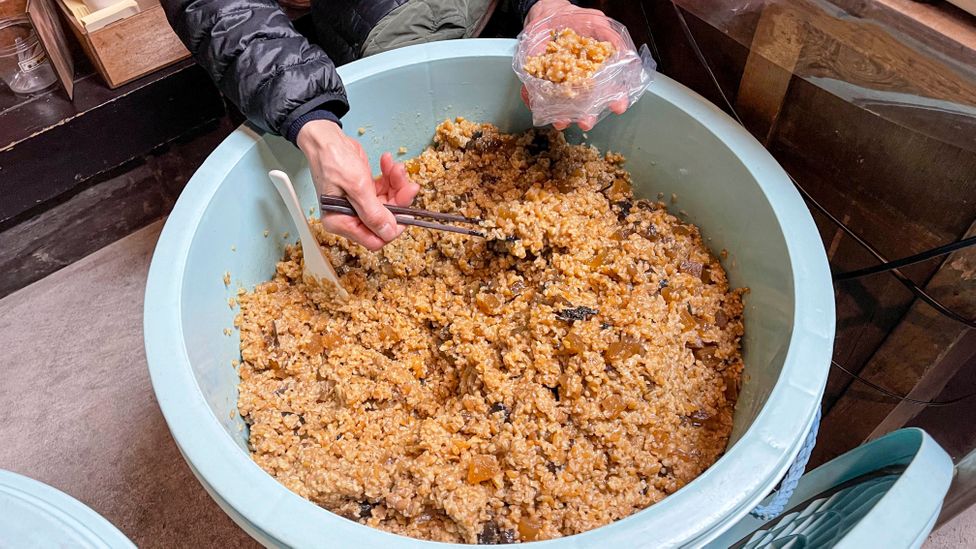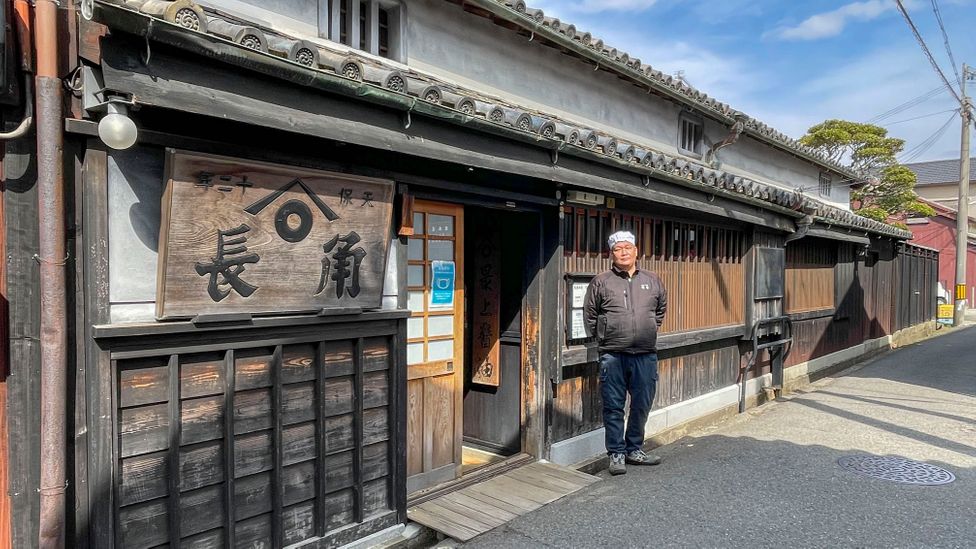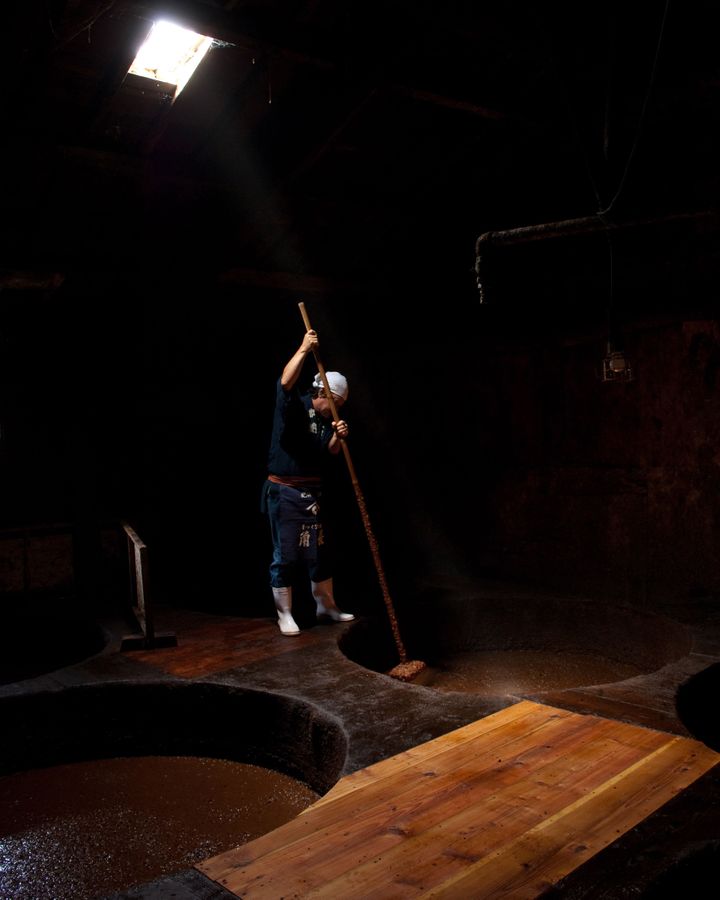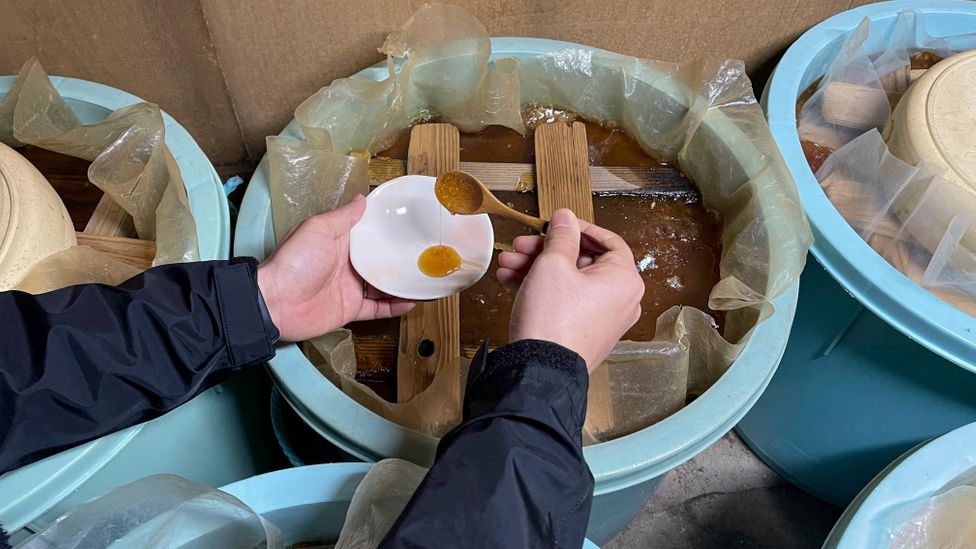Carefully climbing the steep stairs, I followed Tsunenori Kano into the loft of the fermentation room of his family's 180-year-old soy sauce brewery, Kadocho. The dark space was eerily silent except for the creaking of my steps on the old wooden boards laid between the vats of soy sauce. The soy sauce was now dormant, it being late winter, but it still filled the air with a savoury aroma. Around me, a thick, fungus-laden crust covered the ceiling, hung from the beams and grew up the walls.
"That is the bacteria and yeasts that are as old as the building," said Kano, the seventh-generation brewer, "they provide the authentic taste."
I was in Yuasa, a quiet port tucked into a bay on the western coast of the Kishu Peninsula in Wakayama Prefecture, on a quest to learn about the ancient origins of the holy grail of Japanese cuisine: soy sauce.
Soy sauce is arguably the most important seasoning in Japanese cooking. Its well-balanced, salty-sweet taste and deep layer of umami richness make nearly all foods taste more delicious and satisfying. Its uses range from a dab on sushi to a splash into noodle soups and stir-fries, as well as the featured flavour of glazed dishes like teriyaki.
In 2017, Japan's Agency for Cultural Affairs designated Yuasa a Japan Heritage Site for being the birthplace of soy sauce, which is said to have been first made here in Japan in the late 13th Century.

Kinzanji miso remains a popular local delicacy, enjoyed as a snack, side dish or even light meal (Credit: Tom Schiller)
The now-beloved condiment came about soon after a Japanese Buddhist monk named Shinchi Kakushin returned from a trip to China and became the abbot at Kokoku-ji Temple near Yuasa. He brought with him a recipe for making Kinzanji miso, a uniquely chunky type of miso made from whole soybeans, various other grains (such as barley and rice) and vegetables. Yuasa's townsfolk soon discovered that the small amounts of liquid that pooled in tubs of fermenting Kinzanji miso, as its ingredients were pressed down with heavy stones, was in itself delicious. This by-product, called tamari (a generic word that means "to accumulate") became the basis for soy sauce as we know it today.
You may also be interested in:
• Is Japan losing its umami?
• Japan's unknown indigenous cuisine
• Japan's little-known seafaring past
Within years, Yuasa was transformed from being a waystation on the Kumano Kodo pilgrimage route that leads to the renowned temples and shrines on nearby Mt Koya into Japan's most important soy sauce brewing centre. At its peak, the tiny town of just 1,000 or so houses was crowded with more than 90 soy sauce breweries, almost one soy sauce shop for every 10 homes.
Today, the town's historical district is protected by Japanese law. It is an extensive area encompassing 323 houses and other hongawara-buki (traditional buildings) recognised for their immense cultural value. Many of them still have their traditional lattice windows and curved tile roofs, architectural features that were symbols to passers-by of the owners' prosperity. They include five soy sauce shops and six Kinzanji miso makers that are still active. Visiting them tells the remarkable story of the intertwined fortunes of Kinzanji miso and soy sauce.
The distinctive flavour of Yuasa soy sauce reflects its ancient origins from Kinzanji miso. Unlike other types of miso, which are pastes used as seasonings, Kinzanji miso is an elegant tasting, nourishing dish. It's a culinary relic of Song Dynasty cuisine – considered one of the world’s great developments in cooking when exquisite new tastes were created from ordinary ingredients – and has remained a popular local delicacy over the centuries, enjoyed as a snack, side dish or even light meal when added to a bowl of rice or mixed into chagayu (a porridge made from rice, water and tea). It was served at every meal I had while in Yuasa.

Tsunenori Kano is the seventh-generation brewer at Kadocho (Credit: Tom Schiller)
As its tamari byproduct was so tasty, locals wanted a way to produce larger amounts of it. They efficiently adapted the Kinzanji miso-making process to create soy sauce, a thinner, yet similar tasting, form of the tamari.
Established in 1841, Kadocho is one of the oldest of Yuasa's remaining soy sauce brewers; the soy sauce they produce is as close to the original type as you are likely to find anywhere in Japan.
As we descended from the loft, Kano walked me through the brewery and explained how the soy-sauce making process was adapted from that of Kinzanji miso.
Pointing out ancient wooden tools and iron equipment, he said that to make soy sauce, just two, rather than a variety, of grains, are used – steamed soybeans and toasted wheat – which are mashed rather than left whole (as is the case for Kinzanji miso) to better extract their flavour and umami.
They're then mixed with koji kin (green Aspergillus oryzae mould spores), as is done for Kinzanji miso, and left for three days in an enclosed room, called a muro, where the temperature is carefully controlled. There, the grains germinate, their starches converting into sugars, enabling fermentation. This mash is next put into wooden barrels with copious amounts of fresh water and salt – rather than the watery vegetables used for Kinzanji miso – and the brew is fermented for at least 1.5 years to acquire the same kind of mellow, complex flavour that Kinzanji miso has.
A powerful-looking man, Kano said that much of the work is done by hand. This includes regularly mixing the mash in his 34 large barrels with long wooden paddles and pressing the soy sauce from the mash when it is ready. Last, Kano slowly heats the soy sauce in an iron cauldron for half a day to stop its fermentation, using pine wood for the fire.

Very little soy sauce is still made in the traditional way, using wooden barrels and long paddles (Credit: Ryouchin/Getty Images)
Only about 1% of the soy sauce produced in Japan by some 1,200 companies is still made in the traditional way using wooden barrels, according to Keiko Kuroshima, a licensed soy sauce inspector and evaluator. One of Japan's three self-styled soy sauce sommeliers, she is the author of the definitive guide to soy sauce Shoyu Hon (Soy Sauce Book), published in 2015.
"Other soy sauce is mass-produced in stainless steel tanks with the aim to create a consistent taste in as short a period of time as possible, often using artificial means to accelerate fermentation," she said. "The wooden barrels help create a greater diversity of flavour because of the micro-organisms that live in them. They also better reflect the skills of the brewer, their being more engaged in the process."
Kadocho's soy sauce, whose flavour is characteristic of soy sauces made in Yuasa, has a thick body and powerfully rich taste, yet is pleasantly aromatic and mellow, like a well-aged cognac. Its flavour partly reflects Kano's use of a higher ratio of protein-rich soybeans to wheat than the industry standard.
Most brewers, even traditional ones, use a 50:50 ratio of soybeans to wheat, which produces a thinner, lighter-tasting soy sauce. Kubota Soy Sauce Brewery, another old Yuasa brewer, makes two kinds of soy sauce. One, I was surprised to learn, is made with as much as 80% soybeans and only 20% wheat. The other one, matriarch Fumiyo Kubota told me, is their "light" soy sauce. It is made with 70% soybeans and 30% wheat. When I stopped by, she was busy preparing koji – the mixture of koji kin and soybeans and wheat – in preparation for a new batch of soy sauce that will brew for the next 1.5 to two years.
The number of Yuasa's soy sauce brewers has dramatically declined over the last century. The main factor is competition from mass producers, "who compete primarily on price given the standardised quality of their soy sauce," according to Kuroshima. Traditionally made soy sauce is roughly two to three times more expensive than mass-produced soy sauce. "The competition is so intense that it is not only putting the traditional brewers out of business but also mass producers in recent years," she said.

The liquid that pooled in tubs of fermenting Kinzanji miso became the basis for soy sauce as we know it today (Credit: Tom Schiller)
One man who is bucking this trend is Toshio Shinko, who is working to re-establish Yuasa's position as a leading maker of soy sauce. He is the fifth-generation head of Kinzanji miso maker Marushinhonke, a business started by his great-great-grandmother in 1881. In 2002, Shinko created Yuasa Soy Sauce, located in a slick new building on a hill overlooking the town.
His aim, he said, "is to make the best soy sauce in the world" by combining the best possible ingredients with old techniques, such as using wooden barrels, along with new production methods. His featured soy sauce, called Kuyo Murasaki, includes a special ingredient: some of the rare tamari by-product from his family's Kinzanji miso. Shinko has also created a line of specialty products, including organic and halal soy sauce, to ensure the condiment's place at the table for years to come.
Yuasa's official recognition as the birthplace of soy sauce has revitalised the community, promising more variations and uses of soy sauce. To celebrate this exciting future, before I left Yuasa Soy Sauce, I stopped by its cafe and treated myself to a cone of its deliciously rich soy-sauce ice cream.
---
Join more than three million BBC Travel fans by liking us on Facebook, or follow us on Twitter and Instagram.
If you liked this story, sign up for the weekly bbc.com features newsletter called "The Essential List". A handpicked selection of stories from BBC Future, Culture, Worklife and Travel, delivered to your inbox every Friday.
"Sauce" - Google News
March 23, 2022 at 09:11PM
https://ift.tt/kfvWd6u
Japan's humble birthplace of soy sauce - BBC.com
"Sauce" - Google News
https://ift.tt/9BoMZKH
Shoes Man Tutorial
Pos News Update
Meme Update
Korean Entertainment News
Japan News Update
Bagikan Berita Ini














0 Response to "Japan's humble birthplace of soy sauce - BBC.com"
Post a Comment